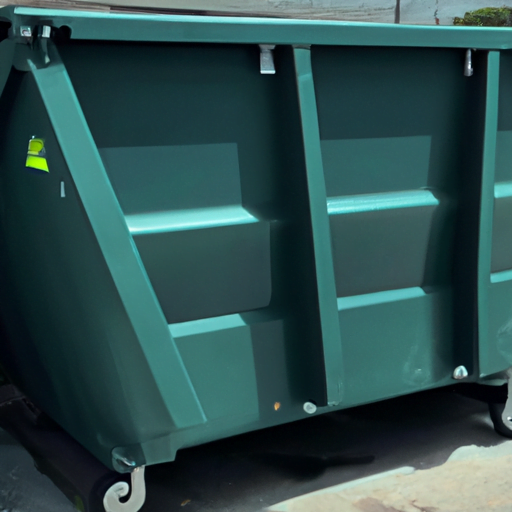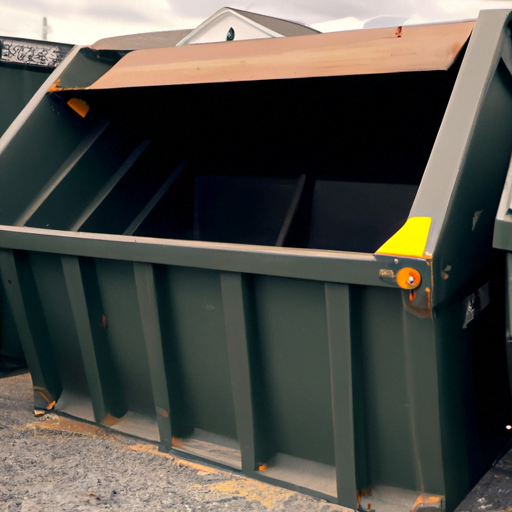-
Table of Contents
Introduction
Selecting the appropriate dumpster size is not only essential for effective waste management but also plays a significant role in saving time, reducing costs, and preventing frustration. In this comprehensive guide, we aim to provide detailed insights into how choosing the right dumpster size can optimize your waste removal process. We will discuss diverse factors that need consideration when determining the best dumpster size for different projects or uses. This includes understanding volume measurements, estimating trash quantities accurately and effectively managing various types of wastes from residential clean-outs to large-scale construction debris. This knowledge is crucial for efficient operations, avoiding unnecessary expenses associated with over-sized or under-sized rentals and averting potential difficulties due to improper disposals.
Maximizing Savings and Efficiency: Selecting the Right Size Dumpster
If you’re embarking on a construction project, planning an extensive cleanup, or undertaking any activity that generates significant waste, hiring a dumpster is likely on your to-do list. Dumpster rental is an efficient and convenient way to dispose of large amounts of garbage at once. But did you know? There’s an art in choosing the right size – it can save time, money, and frustration! Allow us to guide you comprehensively.
Let’s start with this: selecting the correct dumpster size isn’t just about fitting all your trash into one container—it also has financial implications. Opting for a smaller-than-required capacity might seem like saving up-front but think it over; if that results in extra rentals or additional disposal trips (because not everything fit at first), there go your supposed savings! Conversely, should you hire an oversized option ‘just to be sure,’ unnecessary rental costs may pile up like unwanted junk.
Therefore understanding project requirements becomes critical because every job calls for different kinds of dumpsters varying by dimensions and purpose. Sizes usually range from 10 cubic yards—which are perfect for lighter jobs such as small remodeling projects or garage cleanouts—to substantial 40 cubic yard behemoths often found on commercial construction sites handling heavy materials.
So how do we go about deciding?
Firstly evaluate the type and volume of waste generated by your project – knowing what goes inside will help determine its suitable home-outside-your-home! Pile-up tasks including cleaning out homes before moves make mixed-waste scenarios where items vary widely by shape-size-weight; conversely specialized tasks such as roof replacement tend towards single material usage which simplifies estimation! Start mapping ballpark sizes based on commonly listed capacities against typical job-types advertised by rental companies—they’ll have indicated optimal matches helping gauge relative scale!
But remember don’t cut too fine—provide some elbow room accommodating uncertainties inherent in estimations—a touch larger to contain unexpected ‘surprises’ thrown up during work without inviting ‘extra-costs’, is always wiser!
Then consider access issues specific to your location — whether there’s sufficient space available around drop-off points comfortably accommodating selected containers while allowing unhindered loading-unloading operations needs consideration too–inadvertently causing inconveniences could invite further troubles dealing with regulatory bodies strictly overseeing practicalities engulfing placements/discharges publicly accessible areas especially urban settings.
Finally consult professionals providing these services—they come equipped with experience-related insights making evaluations easier ensuring clients receive best value—helpful tips can turn complicated decisions into seemingly straightforward choices involving simple juxtapositions between demand-supply leading onto common-sensical conclusions—weighing options advisedly builds confidence faster than navigating solo fearing missteps along unfamiliar paths avoiding pitfalls others might’ve fallen prey earlier.
In essence choosing correctly sized dumpsters essentially distils down managing expected outcomes effectively controlling variables within set parameters maintaining financially viable balances preserving sanity working through complex situations unravelled systematically arriving reasonable solutions serving interests broadly bringing together divergent aspects fruitfully harmonising resultant entities bundling benefits under unified categories positively impacting bottom lines shrewdly maximising efficiency transforming ordinary transactions significantly valuable experiences building lasting relations beneficial parties involved henceforth.
Choosing wisely really pays off–the selection process itself becomes educational standing future beneficiaries liberating knowledge-power invaluable resource beyond imaginable measuring scales used factoring monetary gains alone expanding horizons unfettered imagination bridging gaps real-ideal world integrating multiple perspectives revealing hidden potentials untapped spaces unveiling bright possibilities ahead waiting eagerly welcoming onboard participants sharing equally arrival abundant rewards hard earned endeavors thoroughly worth considering seriously starting now onwards!
The Comprehensive Guide to Choosing Your Ideal Dumpster Size
Choosing the Right Size Dumpster is more of an art than it seems. It has a significant impact on not just your budget but also how efficiently you manage waste disposal, eliminating unnecessary hassle and frustration in the process. We’d like to offer you this comprehensive guide aimed at making the task of selecting just the right dumpster size a breeze.
First things first, when we talk about dumpsters, we don’t mean those small bins kept by the roadside or housed in your garage. Instead, think bigger—much bigger! These massive containers are often necessary during substantial home renovation projects or for businesses that generate considerable waste.
Gone are the days where one-size-fits-all was applicable to dumpsters. Today they come in various sizes suited for diverse needs—from 10-yard ones perfect for smaller cleanouts like garage spring cleaning up to 40-yard behemoths designed for major construction jobs that create lots of debris.
So why does size matter? Simply put: cost and convenience!
When you opt for a small dumpster only to find out later that it’s insufficiently sized could lead to time-consuming multiple trips or even having to hire another container—all adding up costs quickly. Conversely, choosing too large results in wasted money as well since rental companies usually price their offerings based on size; hence larger means pricier—no points spending extra bucks renting space you won’t be needing.
Now let’s imagine yourself amidst a big project only realizing midway through that your chosen bin can’t accommodate all waste—it’s overflowing early and regularly! You’re left with two options then: either continue laboriously hauling trash away bit by bit or trying hurriedly getting another bin booked—that too without any guarantee if one would be available immediately given how busy rental services tend to get frequently—an utterly frustrating scenario indeed marring productivity!
But cheer up! Understanding just what volume matches each type gives us insight into making our ideal choice saving ourselves from such griefs—a ten-yarder comfortably takes care of small household tasks while twenty yarders serve medium-sized renovations pretty well—for instance replacing carpets throughout some several rooms house-wide. Stepping into thirty-to-forty yard territory caters successfully towards commercial projects involving heavy materials resulting from demolitions typically generating vast amounts debris requiring these larger containers matching their bulkiness.
Remember though—a few pertinent factors beg consideration before finalizing choices—for example nature waste (heavy material require sturdier builds thus potentially meaning opting slightly upsized models), local regulations prohibiting certain load-levels plus availability actual unit locally lest end-up paying hefty delivery fees bringing-in remotely located units—are complex sounding elements? True—but worry not because good rental service providers happily assist clients deciphering such intricacies helping choose ideally suited models wisely thus saving precious resources every way possible!
Summing-up: always remember—the key successful painless efficient waste management lies astutely picking right-sized dumpster best suiting project-needs ruling-out bothersome time-consumption, escalated expenses, unwelcome frustrations quite easily turning otherwise tedious arduous chore much smoother easier faster manageable affair indeed—that’s magic behind mastering art skillfully choosing appropriate container sizes catering tidily towards diverse rubbish-removal needs ensuring peace mind along-with maximized savings!! Why wait then—just dig-in details today availing yourselves benefits galore awaiting discovery simply going smart-size-wise disposing-off wastes orderly manner!
Avoid Frustration, Save Time and Money: How Correct Dumpster Sizing Makes a Difference
Choosing the right size dumpster for your project can save you a lot of time, money, and frustration. It’s an essential aspect of waste management that many people often overlook until it turns into a headache halfway through a cleanup or renovation project. This guide seeks to shine some light on how correct dumpster sizing makes all the difference.
Imagine you’re remodelling your home and decide to get a small low-priced dumpster thinking it will be sufficient. Halfway through discarding debris, you discover that not only is there no more room in the bin but also piles of discarded materials left over. This dilemma prompts additional expenses as another dumpster rental becomes necessary or incurred penalties for overfilling beyond capacity—a predicament nobody wants themselves in.
On the other hand, opting for an extra-large container might seem like playing safe but could end up being unnecessarily expensive if it isn’t filled up close to its capacity. Not taking accurate stock of your trash load before hiring means losing money on wasted space—an avoidable expense with proper planning beforehand.
So how does one choose correctly? The trick lies in accurately estimating the volume generated by your specific job type and equating this volume to most service providers’ standard sizes—10 yard, 20-yard, 30-yard and 40-yard dumpsters.
For instance: A minor cleanout like garage decluttering might require just a compact 10-yard unit which can hold about three pickup truck loads worth of junk. Medium-scale projects such as carpet removals from big homes or complete deck demolitions would necessitate something significantly larger like twenty cubic yards—the equivalent roughly six pickup truck loads.
A whole house remodel kind-of-project demands nothing less than unrestricted rigs seen mainly at construction sites—the mammoth thirty- to forty-cubic yard containers holding nine and twelve pick-up truckloads respectively—if not more!
Estimating precisely remains crucial because both underestimation—prompting multiple rentals or penalties—and unnecessary oversizing lead down paths we’d prefer avoiding; ones made frustratingly difficult due to loss-time repurchasing products delivered late owing largely from inaccurate initial measurements; besides obvious financial losses arising when attempting economize lacking apt spatial acuity regarding dumpster-fit versus projected disposal-volumes awaiting disposal post completion!
Moreover,it’s critical remembering local rules regulating placement needs concerning these industrial-sized behemoths within residential areas since failure complying incurs harsh fines thereby adding insult injury where merely selecting correctly sized dumpsites resolves everything simply,effectively saving stress,time,money – lots thereof!
Finally,a gentle reminder:not all waste destined indiscriminately any given container: Hazardous components (paint,oil,some electronics) usually require specialized drop-offs recycling centres while heavier materials (concrete,dirt) possibly limit total weight loaded containers.Failing heed these guidelines risks safety,lawsuits compounded heavier-haulage transport-fees.Your provider should offer adequate advice so don’t hesitate asking them questions helping make informed choices—involving right-sized dumpsters—for streamlined wastage-management solutions perhaps little aforethought effectively mitigates otherwise complicated problems reducing one basic task:Throw stuff away!
Remember choosing wisely doesmore than simply providing receptacle rubbish.It helps smoother,cost-effective operations opening timespace completing actual work instead fretting garbage.Now armed insight knowledge making smarter choices,no need fear daunting task deciphering best suited bins mess around.Optimizing processes starting smallest yet profound actions—one them appropriately picking perfect-size-dumpster—is guaranteed ensure successful hassle-free cleanup/renovation ventures onwards.Here’s cleaner greener future planned out well-ahead!
Q&A
1. Question: How can choosing the right dumpster size save me time?
Answer: The correct dumpster size means your waste management project will be handled more efficiently, reducing the need for multiple pickups and deliveries which consumes time.
2. Question: Can selecting an appropriate dumpster size help in saving money?
Answer: Yes, choosing a suitable dumpster size can save you money as it reduces extra costs associated with overfilling or needing to rent additional dumpsters due to space inadequacy.
3. Question: How does picking the right-sized dumpster prevent frustration?
Answer: Selecting the right-sized dumpster prevents stress and frustration by ensuring that all of your trash fits properly without violation of regulations or safety hazards that could result from overfilling a smaller-size bin. With fewer complications in waste disposal, it makes your cleanup process smoother and hassle-free.
Conclusion
In conclusion, choosing the right size dumpster is crucial as it can lead to significant time and money savings. Making an appropriate choice reduces hauling costs, minimizes potential penalties for overfilling, and ensures efficiency in waste management. It also helps avoid frustration that may arise from repeated disposal trips or improper waste handling. Therefore, understanding your debris type and volume before renting a dumpster allows you to achieve cost-effectiveness and stress-free waste disposal.


